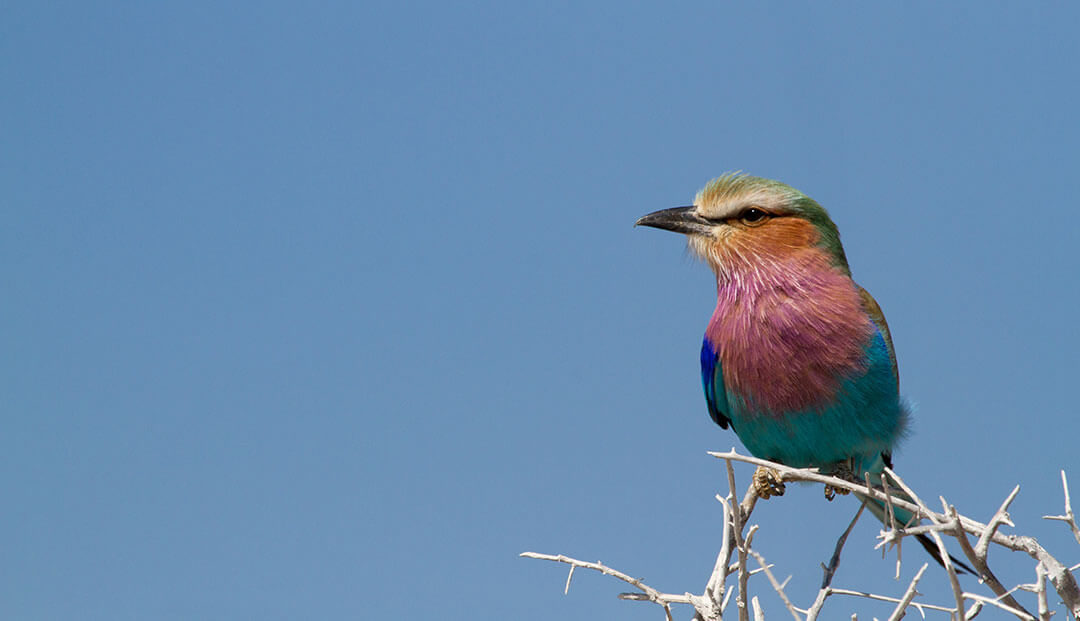The Kruger National Park is one of South Africa’s most popular safari destinations. Each year, thousands of travellers make their way to this iconic park to experience jaw-dropping scenery, unique wildlife encounters, and some of the finest game viewing in Southern Africa. However, for many visitors who book a Kruger National Park safari, it’s all about the birds.
In the following post, we offer a guide to bird watching in Southern Africa, focussing on the Kruger National Park. In the guide we discuss:
- The most common birds in the Kruger National Park,
- Our recommended packing list for your birding safari including the best birding guides, bird watching apps and binoculars for birdwatching.
Top 5 Birds of the Kruger National Park
Of the 900 bird species in Southern Africa, approximately 500 can be seen in the park, whose birdlife is as diverse as its landscape.
Each summer, between November and March, the park’s population expands by 200 migrant species that have flown south either from Eurasia and elsewhere in Africa.
We recommend you keep an eye out for the following birds on your safari vacation:
1. Pel’s Fishing-Owl
A firm favourite, Pel’s Fishing Owl tops many birdwatcher’s lists. It can be spotted hunting along the Luvuvhu River or the Olifants River in the late afternoon.
This elusive species is usually hidden away in the tropical foliage along the banks of rivers. Recent surveys suggest that their numbers in the park remain low, making sighting this majestic bird a truly rare yet memorable one.
2. Lilac-breasted Roller
A common and quintessential sighting, the Lilac-breasted Roller is a small yet breathtakingly beautiful resident of the park.
Preferring open woodlands and savanna, you’re likely to spot one perched on the branch of a tree, with its iridescent green head, lilac breast, and blue wings, surveying the area for prey which includes beetles, grasshoppers, and small lizards.
3. Lappet-faced Vulture
The largest of the vulture family, the Lappet-faced Vulture boasts a wingspan of close to three metres. It weighs up to 10 kilograms and stands almost one metre tall.
Its population is on the decline in Africa, due to its body parts being in high-demand in traditional medicine. This makes the Kruger National Park somewhat of a sanctuary to these birds that spend much of the day soaring at speeds of around 50 kilometres per hour.
4. Southern Carmine Bee-eater
The exquisite Southern Carmine Bee-eater is a migratory species, spending the summer in South Africa before migrating to equatorial Africa from March to August.
They can usually be spotted along river valleys and floodplains and are identifiable by a greenish-turquoise head, richly-coloured pinkish red (carmine) chest, and blue back and rump.
5. Martial Eagle
Africa’s largest eagle, the aptly-named Martial Eagle weighs in at almost 6.5kg (14 pounds), has a wingspan of almost two metres (6 feet 4 inches) and stands almost one metre high.
With a dark brown head and neck, and a white belly with black streaks, they spend most of their time perched high above in the treetops. Martial Eagles are most active between 10 am and 3 pm.
Now that you know some of the most iconic birds to look out for on your Kruger National Park birding vacation, here’s what gear you’ll need to pack.
What to pack for a birding vacation in South Africa
Bird guides for Southern Africa
If you’re planning to visit Kruger National Park, then you will need a copy of the iconic Roberts Birds of Southern Africa or the Sasol Birds of Southern Africa.
These are arguably the best field guides for bird watching, catering to all levels of birders from novice all the way through to professional birders — although the latter could probably identify most birds without the help of a guide. As the most comprehensive and up-to-date field guides, these are an invaluable source of information for travellers on safari in Kruger National Park.
Birding apps for your smartphone
Newman’s Birds app is one of the most popular birding apps in South Africa and is based on Newman’s Birds of Southern Africa, a much-loved birding guide that was first published in 1983. The app features a range of 975 bird species, 1,000 photographs, over 1,300 labelled illustrations and 800 bird calls.
The Sasol eBirds of Southern Africa app is a digital version of the popular field guide and features more than 950 bird species found in the Southern African region, including calls for over 630 species.
One of its best features is the “smart search” function, allowing users to identify any bird using variables like colour, beak shape, size, and habitat. For travellers visiting Kruger National Park, make sure you download the Sasol eBirds of the Kruger National Park app, which features more than 500 species of birds with 1,700 photographs to help you identify your sighting.
Binoculars for bird watching
If you’re headed to the Kruger National Park on the lookout birds, the main piece of equipment you’ll need to pack is a good pair of binoculars. It’s important you understand the magnification of your binoculars, as the higher the magnification, the more difficult it is to keep the binoculars and image steady, which is why most birders opt for 8 x 42 or 10 x 42 magnification.
There is a range of binoculars on the market to suit any birding enthusiast’s needs. An affordable pair of Noptix 10 x 42 binoculars are perfect for beginners, while the Nikon 7576 MONARCH 5 8×42 Binoculars are great for intermediate or professional bird watchers. Ultimately, bird watchers need an eagle eye to spot the bird they’re looking for and a quick and steady hand to get the bird in their binocular’s crosshairs.
We hope you’ve enjoyed this post about bird watching in the Kruger National Park. If you’d like help booking your birding safari in Southern Africa, contact us and we’ll design a tailored itinerary based on your bird watching bucket list.
Armed with the best bird guides, apps, and binoculars, travellers keen on viewing some of Kruger National Park’s incredible bird species have everything they need. Happy twitching!
If you’re a birding fan, let us know your favourite sightings!


Please check out our website and blog for everything related to birds, birders, birding and conservation in South Africa.
https://www.thebirdinglife.com/